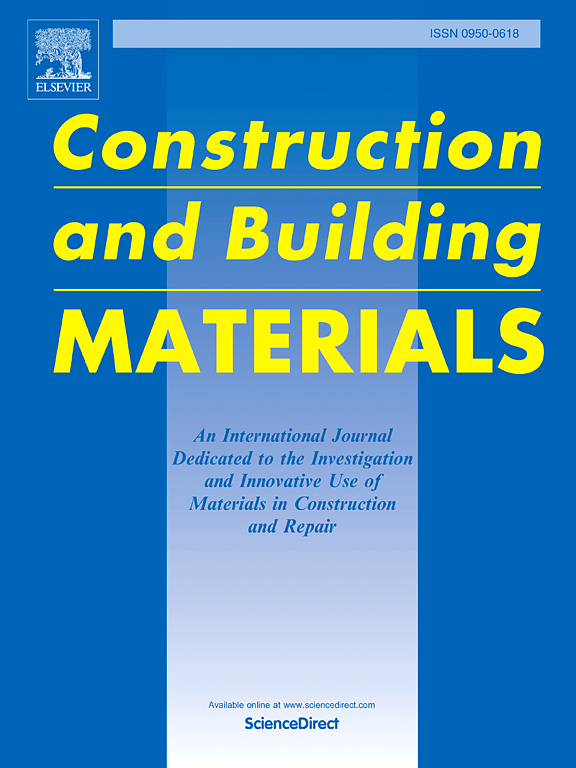The microstructure and mechanical properties of eggshell powder and glass fiber reinforced recycled polyethylene/high-density polyethylene as non-structural building composites
IF 8
1区 工程技术
Q1 CONSTRUCTION & BUILDING TECHNOLOGY
引用次数: 0
Abstract
The output of polyethylene (PE) is enormous and widely used, but the waste polyethylene products pollute the environment. In this study, a new composite material with excellent mechanical properties, good thermal stability and crystallization properties was prepared by using recycled polyethylene/high-density polyethylene (R-PE/HDPE) as matrix, PE-g-MAH was used as a compatibilizer, glass fiber (GFKH) and eggshell powder (ESPKH) treated with silane coupling agent KH550 were used as reinforcement phases. The results showed that the composite containing 30 wt% GFKH and 0.5 wt% ESPKH (GFKH/ESPKH0.5) exhibited significant enhancements in multiple properties compared to R-PE/HDPE. Specifically, its crystallinity, storage modulus, tensile strength, bending strength, and impact strength were measured as 62.9 %, 918.8 MPa, 49.91 MPa, 42.73 MPa, and 10.68 KJ/m2, respectively. These values represent substantial improvements of 33.3 %, 107.9 %, 125.3 %, 115.3 %, and 79.8 % over those of R-PE/HDPE (47.2 %, 441.9 MPa, 22.15 MPa, 19.85 MPa, and 5.94 KJ/m2, respectively). Thermal analysis revealed that the incorporation of GFKH and ESPKH significantly enhanced the thermal stability of R-PE/HDPE. Specifically, the GFKH/ESPKH0.5 composite demonstrated a Vicat softening temperature (VST) of 122.6 ℃ and a temperature at 5 % weight loss (T5 %) of 415.6 ℃, corresponding to increases of 6.9 ℃ and 41.0 ℃, respectively, compared to those of pristine R-PE/HDPE (115.7 ℃ and 374.6 ℃). Through the analysis of variance (ANOVA) parameters P-value and F critical value, it can be seen that ESPKH had a significant effect on the mechanical properties of the composite. This experiment primarily investigates the relationship between composite material properties and microstructure, and it provides a novel approach for modifying recycled thermoplastic resin and designing high-performance composite materials. A comparison of the test results with those of traditional building materials reveals that GFKH/ESPKH0.5 composite exhibits strong potential in the manufacture of sustainable construction components, parts, and products.
蛋壳粉与玻璃纤维增强再生聚乙烯/高密度聚乙烯作为非结构建筑复合材料的微观结构和力学性能
聚乙烯(PE)产量巨大,用途广泛,但废弃的聚乙烯产品污染环境。本研究以再生聚乙烯/高密度聚乙烯(R-PE/HDPE)为基体,以PE-g-MAH为相容剂,以玻璃纤维(GFKH)和经硅烷偶联剂KH550处理的蛋壳粉(ESPKH)为增强相,制备了一种具有优异力学性能、良好热稳定性和结晶性能的新型复合材料。结果表明,与R-PE/HDPE相比,含有30 wt% GFKH和0.5 wt% ESPKH (GFKH/ESPKH0.5)的复合材料在多种性能上有显著增强。具体而言,其结晶度、存储模量、拉伸强度、弯曲强度和冲击强度分别为62.9 %、918.8 MPa、49.91 MPa、42.73 MPa和10.68 KJ/m2。这些值代表实质性改进的33.3 % 107.9 % 125.3 % 115.3 %,79.8 %比R-PE / HDPE(47.2 %,441.9 MPa, 22.15 MPa, 19.85 MPa,和5.94 KJ / m2,分别)。热分析表明,GFKH和ESPKH的掺入显著提高了R-PE/HDPE的热稳定性。其中,GFKH/ESPKH0.5复合材料的维卡软化温度(VST)为122.6℃,5 %失重温度(T5 %)为415.6℃,比原始R-PE/HDPE(115.7℃和374.6℃)分别提高了6.9℃和41.0℃。通过方差(ANOVA)参数p值和F临界值分析,可以看出ESPKH对复合材料的力学性能有显著的影响。本实验主要研究了复合材料性能与微观结构的关系,为再生热塑性树脂的改性和高性能复合材料的设计提供了新的途径。测试结果与传统建筑材料的测试结果进行了比较,结果表明GFKH/ESPKH0.5复合材料在可持续建筑构件、零部件和产品的制造中具有强大的潜力。
本文章由计算机程序翻译,如有差异,请以英文原文为准。
求助全文
约1分钟内获得全文
求助全文
来源期刊

Construction and Building Materials
工程技术-材料科学:综合
CiteScore
13.80
自引率
21.60%
发文量
3632
审稿时长
82 days
期刊介绍:
Construction and Building Materials offers an international platform for sharing innovative and original research and development in the realm of construction and building materials, along with their practical applications in new projects and repair practices. The journal publishes a diverse array of pioneering research and application papers, detailing laboratory investigations and, to a limited extent, numerical analyses or reports on full-scale projects. Multi-part papers are discouraged.
Additionally, Construction and Building Materials features comprehensive case studies and insightful review articles that contribute to new insights in the field. Our focus is on papers related to construction materials, excluding those on structural engineering, geotechnics, and unbound highway layers. Covered materials and technologies encompass cement, concrete reinforcement, bricks and mortars, additives, corrosion technology, ceramics, timber, steel, polymers, glass fibers, recycled materials, bamboo, rammed earth, non-conventional building materials, bituminous materials, and applications in railway materials.
 求助内容:
求助内容: 应助结果提醒方式:
应助结果提醒方式:


